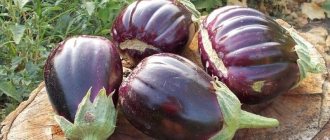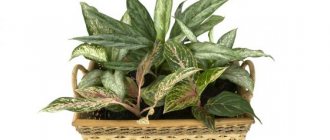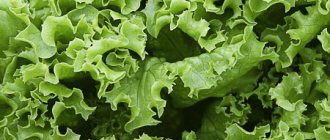“Little blue” eggplants, as many call them, are welcome guests on our table. In addition to the fact that they have a piquant taste, eggplants have many beneficial properties. They contain B vitamins, vitamin A, many minerals - potassium, phosphorus, calcium and others. In addition, it is useful for people with cardiovascular diseases, increases the contractility of the gastrointestinal tract (gastrointestinal tract), and has an anti-atherosclerotic effect.
Among the many different varieties, Epic is distinguished. Read about its features and cultivation rules in the article.
Description of the eggplant variety
The Epic eggplant variety was developed by Dutch agronomists in 2005. It adapts well to various living conditions, and is therefore suitable for cultivation in regions with different climatic conditions.
Hybrid Epic f1
Early ripening hybrid. Suitable for cultivation in greenhouses and open beds. The first fruits begin to taste approximately 60-65 days after planting the seedlings.
Distinctive features (+photo of the variety)
The fruits of the Epic F1 variety are notable for their lack of bitter taste in fresh and cooked form. Epic eggplants also have an attractive appearance: this is a big plus for those who grow crops for sale.
Photo of eggplant Epic f1:
Characteristics of bushes and fruits, taste, yield
This variety is characterized by the following parameters:
- the height of the bushes reaches 1 m;
- spreading bushes;
- the bushes must be tied up, otherwise they will break off under the weight of the fruit;
- there are thorns on the calyx of the eggplant;
- the fruits have a standard appearance, somewhat thickened;
- rich taste without bitterness;
- inside the fruit is white with a yellow tint and with a small number of seeds;
- Eggplant length up to 22 cm, diameter up to 10 cm;
- The yield is high, from 1 m² you will collect up to 6 kg of eggplants.
Features of cultivation
The heat-loving plant is quite sensitive to temperature conditions. It is planted in open ground when stable warm weather arrives, or grown in protected ground conditions. Sowing seeds for seedlings is carried out two or two and a half months before the expected planting date. For cultivation in film greenhouses, this event is planned for early February. Plants can be moved into open ground when favorable weather conditions are established. Therefore, it is advisable to grow it using seedlings.
How to grow this variety yourself
Both experienced gardeners and beginners can grow this variety on their own. To grow the Epic f1 eggplant variety, you will need to purchase seeds and fertilizers, grow seedlings, transplant them to the plot, harvest and enjoy your labors in various dishes. More details about each stage.
Growing seedlings (preparing seeds, soil, planting, care, etc.)
Since this is a hybrid, only purchased seeds are used; you cannot prepare them yourself from your own harvest. Seeds are sown in the first and second ten days of February.
Stage 1. Purchased seeds require preparation before planting: treat with a two percent solution of potassium permanganate and water at a ratio of 2 g per 100 ml. The seeds are dipped in a solution of potassium permanganate for 20 minutes. After the procedure, you need to rinse the seeds in running water and dry. It is better to dry on cotton material; the seeds will stick to the paper and if you try to remove them, you can destroy their structure.
Stage 2. Preparing containers and soil for seedlings. Prepare individual cups, plastic containers with lids or boxes. Fill up the soil. You can mix part of the soil where the seedlings will move with sand and fertilize it with special seedling agents. Or use soil for seedlings from the store.
You can find out how to choose seeds for planting tomatoes here.
Stage 3. Planting seeds. It is necessary to moisten the soil with warm water, immerse the seeds to a depth of 1.5 cm at a distance of 2 cm from each other. No more than two seeds are planted in individual cups. After planting, cover with cellophane and place in a warm place (about 25 C°) in a well-lit place. When the sprouts appear, after 7-10 days, remove the film and place the seedlings in a cooler place (up to 16-18 C°) also with good lighting. Seedlings need to be hardened: moved for some time from a place with a temperature of about 25 C° to a cooler place with a temperature of 13-15 C°, so the plant will become accustomed to the temperature regime in the garden bed.
Stage 4. Fertilize the soil where the seedlings grow. Apply phosphorus fertilizer 10-15 days after germination. Then feed every 2 weeks until planting in the beds. This way you will speed up the growing season, and the seedlings will grow strong and strong.
Stage 5. Preparing for transplantation. When the seedlings reach a length of approximately 20 cm, about five leaves form on the trunk and the time of frost has passed, the seedlings are transplanted into beds or into a greenhouse.
Transfer
Divide your beds or areas in the greenhouse where you plan to transplant eggplant seedlings into 1 m² sections. Imagine that the presented field looks like a chessboard. It is necessary to plant 4-5 bushes on the “white” areas of the visual chessboard at a distance of 60-70 cm from each other.
Further care
Epic does not require special care. Like other plants in your garden, eggplants need to be watered regularly, inspected for pests, and fertilized promptly.
Features of cultivation and possible difficulties
By following the simple rules presented below, you will reap a decent harvest:
- Water moderately and on time.
- Loosen the soil and prevent crust formation after watering.
- Weed, remove weeds.
- Fertilize regularly. Make the first feeding of the soil after the seedlings have become firmly established in the new territory. Fertilize with manure, compost, ash and mineral supplements. Fertilize a second time after the flowers appear - this time mainly with minerals. The third time - after the formation of the ovaries, fertilize with superphosphate or use the fertilizer complex “Nitrophoska” and “Ammofoska”.
- Be sure to tie up the bushes. If you don't do this, the stems may break and your expectations for the amount of harvest will not be met.
- If you remove too many stems, you can leave no more than eight.
Diseases and pests characteristic of the variety
Epic eggplants suffer from the same diseases as other eggplants. The variety is susceptible to late blight, gray rot and blackleg. Compliance with the principles of agricultural technology, as well as an annual change of where the crop is grown, will help avoid infection with these diseases. It would also be useful to treat with copper preparations, and for the prevention and treatment of late blight it is worth treating with Zircon.
To get acquainted with tomato diseases and find out how to deal with them, follow the link.
Common pests of this plant include:
- Colorado potato beetles - get rid of them by manually collecting insects; plant basil to repel them;
- slugs - they are also collected by hand; in case of a huge number, the ground is sprinkled with a mixture of lime, ash and tobacco dust;
- spider mites - get rid of them with the help of drugs “Strela” or “Keltan”, which are safe for humans.
Preparing to grow seedlings
Summer residents usually begin planting seedlings in late winter or early spring. To do this, purchase soil for seedlings and planting material from a specialized store. Purchased seeds must be stratified. That is, simply put, they need to be hardened. Before this procedure, summer residents carry out several activities for seeds:
- Treat with a 2% solution of potassium permanganate, immerse the planting material in it and leave for 20 minutes. To do this, dissolve 2 g of potassium permanganate in 100 ml of water.
- Disinfect the seeds in a solution of 100 ml of water and 3 ml of hydrogen peroxide. Heat the prepared solution slightly and leave for 10 minutes. place planting material in it.
Read more: Long-awaited grapes description of the variety
Before planting, first purchase soil for seedlings from a specialized store. It is already in a ready-made state and does not require additional interventions. If you purchase ready-made planting material in a store, you also do not need to process it.
You can prepare the soil yourself, and for this, summer residents take fertile soil, mix it with peat and sand, adding superphosphate, urea and potash fertilizers. In addition, your soil should be disinfected by heating or freezing it.
When starting to plant seedlings, you should keep in mind that this variety does not tolerate picking. The purchased soil is placed in prepared containers and moistened abundantly. A grid with squares of 6x6 or 8x8 cm is laid on the surface, depending on the type of plant.
1-2 seeds are placed in each nest and planted to a depth of 1-2 cm. In the future, with this planting scheme, 150-250 seedlings should emerge. After planting, the seeds are sprinkled with a thin layer of light soil and moistened again, using a spray bottle.
In addition to the common container, seeds can be planted in separate cups, and then placed in a common container. Fresh plantings are covered with plastic wrap and put in a warm place. After 14 days, the first shoots will appear. When the seedlings get a little stronger, they should definitely be hardened off.
Based on reviews from gardeners and farmers, we can say that the Epic F1 eggplant is a reliable and powerful hybrid. You cannot get its seeds yourself. They are produced by the company TM Seminis (Holland). The seeds are dense and not large.
There are up to 300 of them in one gram. Germination persists for 3-5 years. Eggplant seeds have a long germination period. Pre-sowing seed treatment has a beneficial effect on the germination and quality of future planting material. They are sorted, treated with disinfecting solutions and growth stimulants, soaked and germinated.
Harvesting and use of crops - storage, use in cooking, preparations
Seedlings planted at the end of May will bear their first fruits in late July - early August. You will harvest in batches; the eggplants will ripen gradually. Storing fresh is problematic; the fruits will quickly deteriorate. It is better to cook fresh, or chop and freeze or dry.
Epic eggplants are used to make winter preparations - caviar, Peking-style eggplants, salted eggplants, spicy Korean-style fire. There are hundreds of recipes for canning and freezing.
The easiest way:
- Cut the eggplants and bake in the oven at 200 degrees.
- Remove the skin when ready and place the vegetables under a press to remove excess liquid.
- Place in bags and place in the freezer.
In cooking from Epic f1 they prepare marinated, baked, stewed eggplants stuffed with garlic and herbs, rolls with curd cheese and dill and a lot of other dishes.
You can also prepare a lot of delicious dishes from pumpkin; recipes are here.
Advantages and disadvantages of the variety
The undeniable advantages of the variety include:
- resistance to tobacco mosaic disease;
- resistance to sudden temperature changes;
- pronounced taste;
- high productivity;
- easy to care for;
- universal to use.
There are also disadvantages:
- growing only by seedlings is a relative disadvantage, since in our climate all varieties of eggplant have to be planted as seedlings;
- does not tolerate low temperatures well - in cold summers one cannot count on a bountiful harvest;
- It is not stored for long after being picked from the bush.
Characteristics of the hybrid, according to the State Register (table)
| Ripening period | early |
| Bush | tall, semi-spreading |
| Stem | medium pubescence, with anthocyanin color of medium and weak intensity |
| Sheet | green, medium size |
| Spikes on the cup | yes, rare |
| Fruit shape and size | leveled, cylindrical, medium length and diameter |
| Fruit by color | dark purple with gloss, sometimes faint |
| Fruit weight | 220–230 g |
| Pulp | whitish, without bitterness |
| Taste of products | great |
| Marketable yield | 5.8 k/m² |
| Immunity | to tobacco mosaic virus |
Reviews from those who grew
Here are a few reviews from gardeners who grew the variety on their own plots.
Dmitry, Saratov: “Among the eggplants that I grew, the most delicious and unpretentious variety is Epic F1. Planted in a greenhouse and in the garden, the yield is excellent under any conditions. Fresh and young eggplants are good for frying in oil and grilling. Each bush produced 6-7 fruits. I always choose hybrids, they grow better and the yield is high.”
Anatoly, Novosibirsk: “A magnificent hybrid. The main thing is not to plant in the same place. I've been growing this for three years now. I scatter onion or garlic peels with straw on the eggplant bed. The husks repel pests, and the straw maintains the right moisture.”
To learn the best way to protect your garlic crop from pests, read this article.
Your personal gardening consultant!
Epic eggplant, according to experienced gardeners, is the most unpretentious vegetable to grow in open ground.
Lovers of blueberries prefer this particular variety because there are no problems with planting, the yield is good, and the taste of the fruit is excellent. Plus, the variety is early, you don’t have to wait long for ripe fruits, only about 3 months. Breeding characteristics of the variety
What can be said special about the epic f1 eggplant, the cultivation and care of which complies with all the rules? Nothing special - eggplant is just like eggplant. But at the same time, the culture would not be so popular among blue-haired lovers if everything were so simple. The variety, so to speak, has no peculiarities, but it does have individuality. How does Epic differ from all other varieties?
— The fruits of the crop are not always the same in shape. The fruits can be smooth, cylindrical, or have a thickening at the end. Like a pear, only very long. The color of eggplant is always dark purple. There are spines on the cups, but not many of them.
— Depending on the attention and hard work paid to planting, the size of the fruit and weight are different. During normal cultivation, the length of mature eggplants ranges from 21 to 24 centimeters, the diameter from 8 to 10 cm. If you try very hard and make every effort, eggplants can be grown up to 25 centimeters long and weighing up to 500 grams.
— The pulp is tasty without bitterness, white in color. True, a little dense, but still tender, almost without seeds.
— The bush is strong, one might even say powerful. The height of the bush is about 90 cm.
The fruits store well, and they are even better in cooking. You can do whatever you want with eggplants. You can fry, boil, stew, bake in the oven or grill, dry, and so on, as far as your imagination allows. In terms of productivity, Epic eggplant is also not in last place; from 1 m² you get up to 6 kilograms of blue ones.
To grow real varietal eggplant epic f1 in beds or under cover, cultivation and care must be carried out in compliance with simple, but mandatory rules. Yes, there are rules, and if at the beginning it was mentioned that the vegetable is unpretentious in terms of growing conditions, this does not mean that you will not have to do anything at all. Although they are minimal, there are still requirements for caring for the crop.
1. Much has been said about this and yet, first of all, attention should be paid to the soil. For eggplants, it should always be loose and fertile. If the soil is dense and poor, sand, peat plus humus are added. Sand and peat quantity is determined on site. Add enough of one and the other to slightly fluff up the dense soil. Half a bucket of humus is enough for 1 m².
2. When selecting seedlings for a permanent place of growth, it is recommended to follow a planting pattern of 60×60 cm. If there is a lot of space, the distance between rows can be increased to 70 cm.
3. In the first week and a half after planting, the plants are watered sparingly, that is, not often and little by little. In the future, watering is carried out once every 3 days. In dry weather, the amount of water needs to be increased. How much depends on the condition of the soil. Water is added as soon as the soil begins to dry out. But the main thing here is not to overdo it. Excess moisture provokes the appearance of fungus.
4. When it becomes clear that the seedlings have taken root, the Epic eggplant is fed. Regular feeding of plants is carried out with any fertilizers (minerals or organic matter) that are used to feed any other variety. Just remember that before and during the ripening of the crop, it is better to use organic matter rather than chemicals. Same benefit, no harm.
5. Formation of a bush. For eggplant epic f1, reviews from experienced gardeners indicate that a correctly formed bush is a bush of 3 branches. With fruits, it’s not so simple either; there is a limitation. Since the fruits can grow quite large, there should be no more than 8 of them on one bush. In order not to suffer later on which eggplant to keep and which to throw away, it is better to regulate fruiting during flowering and the appearance of the ovary. Eight of the best and most promising flowers were chosen, the rest were torn off, that’s it, the question is settled. When the bushes become tall, they are tied up.
6. In terms of diseases, according to the description, Epic eggplant has no particular negative aspects. To some extent susceptible to diseases, but not much. The only disease to which the plant has excellent immunity is tobacco mosaic.
7. How to deal with harmful animals? If you don’t take into account the chemistry, everything is clear, a solution of wood ash helps with colorados. 500 grams of ash are dissolved in a bucket of water, and the resulting solution is sprayed onto the plantings. The procedure is carried out every week, there seem to be fewer beetles. There is also a remedy, at least for eggplant epic f1, reviews of some gardeners confirm this, this is plant protection with the help of flour. Only the flour should be salted, and for such a mixture it is better to use Extra salt. The procedure involves complete “pollination” of all plantings.
There is no point in considering growing seedlings again; the whole process was described in a previous article. We need to add something about the yield. Sometimes novice gardeners have a question about where it is more appropriate to plant Epic eggplant (in a greenhouse or in open ground) in order to get a larger harvest. In this case it makes no difference. The variety’s yield is equally good both under cover and in the garden. The only note when determining the timing of harvesting is to remember that in overripe fruits the pulp becomes loose, the peel is thick and hard.











